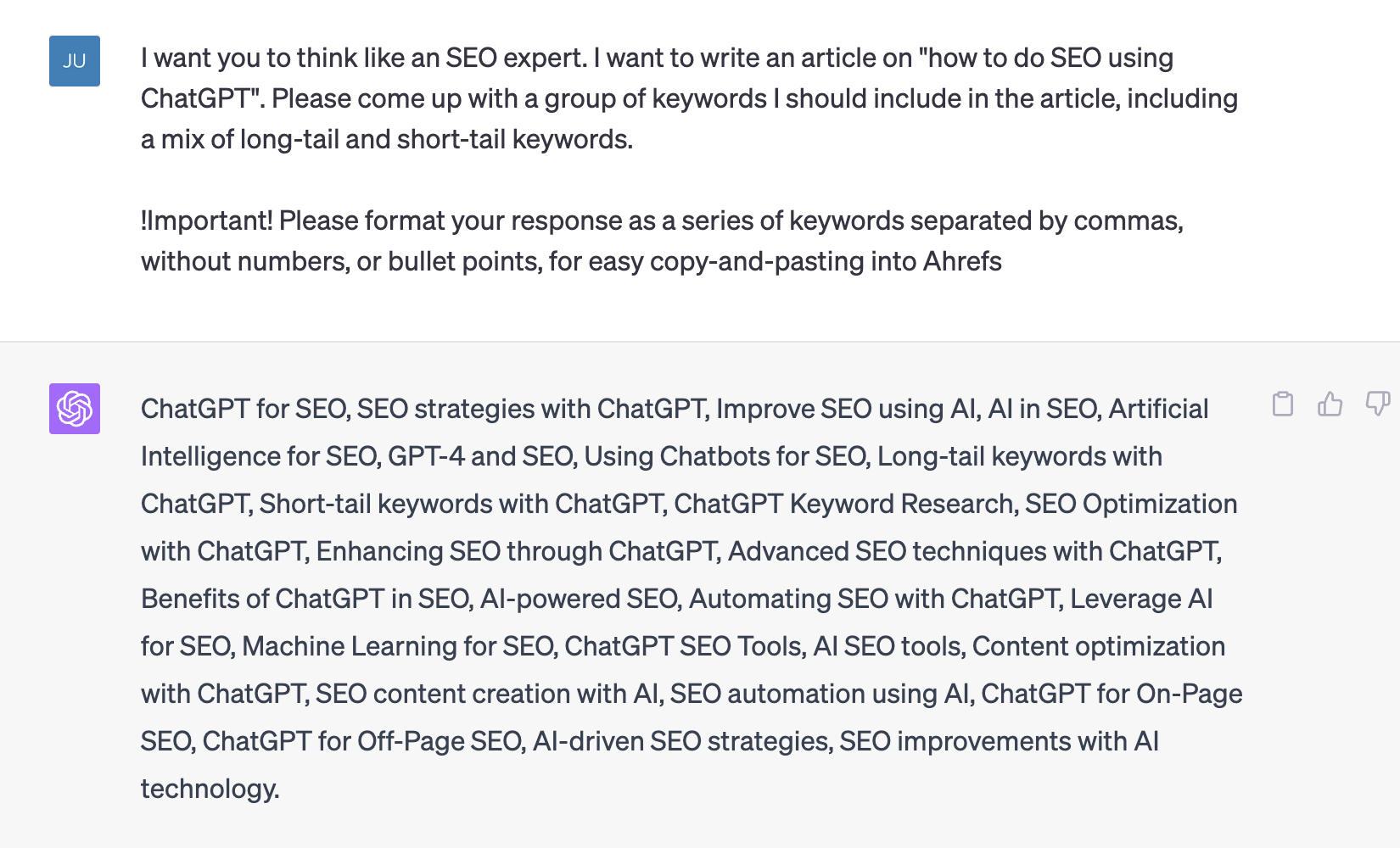In today’s post, we’ll be exploring efficient ways to optimize your SEO strategies, especially when you’re operating within the constraints of a side hustle.
Obviously, the whole world is talking about ChatGPT right now and we’d be remiss to not provide some suggestions on how to utilize it in your SEO efforts.
Let’s delve into understanding how this AI can be an ally in managing SEO tasks, and subsequently, aiding in the growth of your online presence.
This article will give you some tips on how to apply time-efficient SEO strategies to your side hustle, so you can make the most of your limited time and see those search rankings jump as quickly as possible.
Time-Efficient SEO Strategies Using ChatGPT
Not surprisingly, one clever way to speed up your SEO process is by using ChatGPT.
With ChatGPT, you can automate time-consuming tasks and focus on other crucial aspects of creating and optimizing your content.
Here’s a few ways you can use it
Keyword Research
While ChatGPT can’t give you the actual insights you’ll need to understand how many times per month something gets searched, or how competitive the competition is for those terms, it CAN give you a great starting point of things you might want to cover.
For example: To write an article on “how to do SEO using ChatGPT”, I entered the following:

I then took that list and copied it into ahrefs to get the data I needed, and ultimately here’s what I found:

(in case the text is too small here, it’s saying that it can’t find data for most of the keywords)
While Ahrefs wasn’t able to find data on MOST of the keywords that ChatGPT suggested (implying that very few people — if any — actually search for these on Google), it did come back with a few.

From those? Not much, to be honest.
The term “AI SEO tools” has 150 monthly searches with low difficulty, but that’s the only thing that really came out of this experiment.
Regardless, if you’ve got access to both ChatGPT and Ahrefs, this only takes 1-2 minutes in practice, so tinker with it and you might come up with something great.
ChatGPT can help you generate keyword-rich content, saving you time and effort in creating high-quality, SEO-driven articles.
Optimizing Existing Content
If you already have content on your site, the fastest way to see SEO growth is to update and optimize it.
If your content has been on Google’s index for a while and isn’t ranking, showing your articles some love can help improve their performance.
Make sure that every page or post you want to drive traffic from Google targets a specific keyword or search query (check out our keyword gameplan to help make this easy)
Alternatively, you can get the data you need by learning the big name SEO tools like Ahrefs or SemRush to get the job done.
We personally use Ahrefs but they’re extremely similar.
Update Your Content
Content optimization and generation can be time-consuming, but not with ChatGPT.
Refresh older posts by adding new information, removing outdated content, and improving readability.
Feed it your existing content and ask where to incorporate your target keywords for improved SEO, to incorporate relevant long-tail keywords and optimize your meta data.
Add Internal and External Links
This is something that ChatGPT can’t do on your behalf, but as you’ll recall from our discussion on Topic Clusters, internal links are extremely important for your articles.
You CAN feed your articles into ChatGPT and ask it to review content in order to find areas that would be logical to add relevant external links, saving you potentially 5-10 minutes per article.
Remember to vary your anchor texts to show Google the various potential ranking keywords for each linked page.
Important! Don’t use the same anchor text everywhere or you’ll be wasting valuable link juice!
Improve Content Structure
Ask ChatGPT for help formatting your content by breaking up long paragraphs with headings that include relevant keywords, bullet points, and lists for easier readability. It does a great job at tasks like this.
Pro Tip:
Consistency is key — regularly publishing new, optimized content and updating old, outdated content will help build your domain authority and improve your search rankings over time.
For Every Article, Prompt it to Use This SEO-Optimized Content Template
Here’s a checklist to help you save time when creating content by using this SEO-optimized content template.
Each of your articles should include the following. (you can literally copy and paste this into chatgpt so that it handles this all on your behalf)
1. Title (H1)
Catchy, keyword-rich title that accurately represents your content
2. Introduction
Engaging intro that hooks the reader and sets the stage for the rest of the article
3. Main Points (H2)
Organize your content with clear, concise headings that include your target keywords
4. Subtopics (H3)
Break down your main points into smaller, more digestible subtopics as needed
5. Images
Include relevant images with descriptive alt text and captions to improve user experience and SEO.
6. Conclusion
Recap the main points and tie them back to the importance of the topic to your reader’s goals. End with a call-to-action that encourages engagement or conversion.
7. Meta Descriptions
Optimize your meta title and description with your target keywords and make them enticing for users to click.
8. An Optimized URL
Include the target keyword in the URL and keep it short and descriptive.
If you change the URL of a previously-published page, be sure to set up a 301 redirect to avoid broken links and potentially huge SEO issues.
Conclusion
SEO can be tough even when you have 40 hours a week to devote to it. Trying to find success with it on less than that requires that you do things right and efficiently.
By focusing on optimizing your existing content, leveraging tools like ChatGPT, and using the SEO-optimized content template for future posts, you can make the most of your limited time and grow your online presence.
The tips and insights shared in this article are designed to help you maximize your limited time and inch closer to your ultimate goal—turning your passion project into a sustainable source of income.
If you have any questions or need further assistance, don’t hesitate to reach out. Wishing you the best of luck in your side hustle journey!
-Justin
Help With Your Hustle
